Natural Resources, 2017, 8, 531-547
http://www.scirp.org/journal/nr
ISSN Online: 2158-7086
ISSN Print: 2158-706X
Assessment of Hybrid Concentrated Solar
Power-Biomass Plant Generation Potential in
Sahel: Case Study of Senegal
Ababacar Thiam1,2, Cheikh Mbow3, Mactar Faye1,2, Pascal Stouffs4, Dorothé Azilinon2
1Efficiency and Energetic Systems Research Group, Alioune Diop University, Bambey, Senegal
2Latep, Université de Pau et des Pays de l’Adour, Pau, France
3Faculté des Sciences et Technique, Université Cheikh Anta Diop, Dakar, Senegal
4Laboratoire d’Energétique Appliquée, Ecole Supérieure Polytechnique, Université Cheikh Anta Diop, Dakar, Senegal
How to cite this paper: Thiam, A., Mbow,
C., Faye, M., Stouffs, P. and Azilinon, D.
(2017) Assessment of Hybrid Concentrated
Solar Power-Biomass Plant Generation Po-
tential in Sahel: Case Study of Senegal. Na-
tural Resources, 8, 531-547.
https://doi.org/10.4236/nr.2017.88033
Received: June 25, 2017
Accepted: July 31, 2017
Published: August 2, 2017
Copyright © 2017 by authors and
Scientific Research Publishing Inc.
This work is licensed under the Creative
Commons Attribution International
License (CC BY 4.0).
http://creativecommons.org/licenses/by/4.0/
Open Access
Abstract
Concentrating Solar Power (CSP) is non-existent in Sahel. Such a situation
arises from the high investment costs required by these energy infrastructures
and from a lack of information on the identification of suitable sites to ac-
commodate them. Conversely, CSP-biomass plants due to lower investment
may be an option for CSP penetration in Sahel where Direct Normal Irradia-
tion (DNI) is between 1400 kWh/m2/year and 2000 kWh/m2/year and signifi-
cant biomass potential. This work presents the results of an identification of
suitable sites for hybrid CSP-Biomass in the Sahel, case study of Senegal, tak-
ing into account the Direct Normal Irradiation, the availability of water, space
and biomass potential. The identified sites have a DNI > 1600 kWh/m2/year.
The biogas production capacity is equivalent to 5,096,563 m3/year. The quan-
tity of Typha Australis, invasive plant in Senegal river valley available is esti-
mated at more than 3 million tons. The capacity of electrical energy in this
zone is estimated at 6.89 GWe for an installation surface estimated at 275.61
km2. The establishment of CSP/hybrid plants can also contribute to combat
the proliferation of Typha Australis.
Keywords
Biomass, Concentrating Solar Power (CSP), Direct Normal Irradiation (DNI),
Hybrid, Typha Australis
1. Introduction
The Sahel, a transitional zone between the Sahara desert and the equatorial fo-
DOI: 10.4236/nr.2017.88033 Aug. 2, 2017
531
Natural Resources
�
A. Thiam et al.
DOI: 10.4236/nr.2017.88033
rests, is a semi-arid region that extends from West Africa to East Africa. With an
area of 7.3 million km2, the Sahel covers the following countries: Burkina Faso,
Eritrea, Gambia, Guinea-Bissau, Mali, Mauritania, Niger, Senegal, Sudan and
Chad. The total population of the Sahelian countries was estimated at 125 mil-
lion habitants in 2013. Their natural growth rates are among the highest in the
world, about 2.5% to 3.8% [1].
Like other countries in sub-Saharan Africa, access to electricity in the Sahelian
countries is limited. Around 32% of the population has access to energy in 2013
[2]. Among people having no access to electricity, 80% live in rural areas and
remain distant from distribution networks.
In front of this situation, off grids are one of the means of access to electricity
for rural communities in the Sahel. The main technologies available for off grids
are generators and renewable energy technologies (solar technologies, small hy-
dropower and small wind turbines).
The economic cost and the environmental impact of the use of generators
make the choice of off grids fueled by renewable energy sources in the rural
areas of the Sahel.
Solar technologies are more suitable in the Sahelian zone because of a high
solar potential of around 5.5 kWh/m2 [3] and low hydroelectricity as well as
wind potential. Wind speeds are indeed low with national averages ranging from
2 to 3 m/s with some peaks of 4 to 5 m/s in some localities [4].
Among solar production technologies, thermodynamic solar power plants
(CSPs) could be an alternative to decentralized production and contribute to the
fight against climate change. Thermodynamic solar power plants (CSPs) con-
centrate solar rays to heat, a fluid that is directed directly or indirectly to a tur-
bine coupled to an alternator. CSPs offer the ability to store heat that facilitates
the management and distribution of electricity. They can be hybridized with a
fossil or biomass energy source to ensure continuous production.
In addition to their capacity to generate electricity, CSPs can also meet heat-
ing, desalination and cold requirements. Since 2009, the CSPs have grown stea-
dily. Between 2009 and 2013, installed capacity increased from 600 MWe to 3959
MWe [5].
Despite its advantages and progress, CSPs are not yet competitive with other
renewable energy technologies. As comparison, the standardized cost of electric-
ity for CSPs is (0.20 - 0.35) USD/kWh for (0.11 - 0.28) USD/kWh to photovol-
taic solar energy and (0.06 - 0.12) USD/kWh to wind turbine [6].
Hybridization with lower-cost fuels (biomass or waste) is also a strategy that
could help reduce production costs and make CSPs competitive. In addition,
while facilitating the management and distribution of electricity with cost ad-
vantages, hybrid plants can extend the siting of CSP plants from arid zones to
semi-arid or temperate zones.
In addition, while standard CSP plants generally require direct irradiation
(DNI) of 2000 kWh /m2/year or more, CSP hybrid plants can be located in areas
where the DNI reaches 1700 kWh/m2/year [7]. This brings CSP plants closer to
532
Natural Resources
�
A. Thiam et al.
agricultural regions with high biomass potential and waste disposal areas.
Among hybrid plants at lower cost, hybrid CSP-biomass plants are a well-ac-
cepted solution for low-cost, base-load and renewable energy [8] and are a niche
for areas with a DNI and Biomass resources.
CSP hybrid plants are beginning to be a reality. In 2012, the first CSP-biomass
“Termosolar Borges” hybrid plant is operational in Spain, demonstrating the
technical and economic viability of this technology. In 2014, India also launched
a project for a 3 MW hybrid CSP-biomass plant equipped with biomass-inte-
grated gasification (SCOPEBIG) [9].
Hybrid plants continue to be the focus of many research activities. Different
configurations have been studied. Peterseim et al. [10] evaluated 17 CSP-bio-
mass hybrid configurations in relation to their technical, commercial and envi-
ronmental performance. Other work has focused on the hybridization of cylin-
drical parabolic (PTC) plants with biomass [11] [12] [13]. The Linear Fresnel
Reflectors (LFRs) have been studied for hybridization with biomass [14]. The
hybridization of solar towers with biomass was also discussed [15] [16].
The lack of information on the identification of potential sites with an ac-
ceptable DNI and the availability of biomass constitutes an obstacle to the dep-
loyment of hybrid CSP-biomass plants in the Sahelian zone. To our knowledge,
the identification of potential sites for hybrid CSP/biomass plants has been done
only for Australia [17], India [14] and Brazil [18]. There are no studies on the
identification of potential sites for CSP/biomass hybrid systems in the Sahelian
zone.
This study aims to fill this gap by focusing on the identification of suitable
sites for the implementation of hybrid CSP/biomass plants in the Sahel for de-
centralized electricity generation. The case of Senegal, located at West Africa
between 12˚08'N and 16˚41'N latitude and 11˚21'W and 17˚32'W longitude, is
studied because of the high potential for biogas production in areas with high
DNI and the presence of large quantities of Typha Australis in the valley of the
Senegal River, which is an invasive plant that colonizes cultivated land.
2. Review of Hybrid CSP-Biomass System Requirement
2.1. Direct Normal Irradiation (DNI)
Like the standard CSP installations, hybrid plants require a high level of direct
sunlight. While the threshold value of the DNI of a site for the implantation of a
standard CSP installation proposed by some researchers varies from 2000 to
1800 kWh/m2/year [8] [9], hybrid systems can be implanted in sites of which
The DNI > 1700 kWh/m2/year [11]. According to Peterseim et al. [19], sites with
a DNI > 1500 kWh/m2/year can be considered acceptable for the implementa-
tion of CSP hybrid plants.
2.2. Land Slope
CSP plant sites must have limit slopes. Cylindrical Parabolic Trough and Linear
533
Natural Resources
DOI: 10.4236/nr.2017.88033
�
A. Thiam et al.
DOI: 10.4236/nr.2017.88033
Fresnel Reflectors require zones with a slope of less than 2%. Solar towers and
Dish can be installed in sites with a slope of less than 5%, but installation on sites
with slopes greater than 2% can lead to additional installations.
2.3. Land Requirement
CSP plants require large areas of earth for the installation of the solar collectors
field, the thermal storage system and the power block. The required area varies
from one technology to another. For a given technology, the land requirement
varies depending on the presence or absence of the thermal storage system and
the cooling method of the power block. In this regard, authors have provided
values on the areas required by MW in Table 1.
The availability of land and possibly its cost are important issues to consider
in choosing a site. In Senegal, land belongs to the state that distributes it to local
communities. CSP plant sites should not be in competition with agricultural
land, nature reserves, residential and industrial land.
2.4. Water Requirement
Water requirements vary from one technology to another. For water-cooled pa-
rabolic (PTC) plants, water consumption is 3000 - 3500 L/MWh [22], water re-
quirements are approximately 2300 L/MWh for Fresnel Linear Reflector (LFR)
[22] and the needs of a solar tower are of the order of 2800 L/MWh [23].
The majority of CSP-biomass hybrid systems operate with the Rankine cycle
(steam generators) in which 90% of the water is used to cool the steam cycle and
the remaining 10% is used to clean the mirrors. Dry cooling systems can dra-
matically reduce water consumption but can result in additional costs. In the
Sahel, a semi-arid zone, water cooling is more efficient because the outdoor
temperature can reach a maximum of 40˚C. The efficiency of air cooling de-
creases when the outdoor temperature is high. Moreover, the Sahel is marked by
a strong presence of dust. Therefore, the hybrid plant site must always have wa-
ter availability.
Table 1. Field requirements for various solar thermodynamic technologies.
CSP technologies
Parabolic Trough
Solar Tower
Land requirement (m2/MW)
18,000 including power block [20]
40,000 [21]
45,000 [20]
83,600 [21]
19,166 [20]
Linear Fresnel Reflector
25,555 (1 h of thermal storage capacity) [20]
Parabolic Dish
534
34,000 (wet cooling) [20]
16,000 [21]
40,460 [20]
Natural Resources
�
A. Thiam et al.
2.5. Biomass Potential
The availability of long-term biomass is an important criterion for the imple-
mentation of CSP-Biomass hybrid plants. The biomass taken or used must not
have a negative impact on the environment. Biomass can be used as a back-up to
a CSP when solar radiation is not sufficient to produce electricity. Alternatively,
biomass can also be used to increase the amount of vapor produced or the tem-
perature of the working gas.
Due to environmental constraints and funding opportunities, the share of
biomass in a hybrid plant should be less than 30%.
2.6. Availability of Power Lines
As with all power generation systems, hybrid CSPs require access to electrical
transmission lines to link supply to demand and roads to transport heavy ele-
ments from the CSP central office. According to Kirby et al. [24], the distance
from the power grid should not exceed 80.5 km and the site should be accessible
by road or rail over 80 km.
3. Methodology
Geographic information system (GIS) tools were used to map the availability of
direct sunlight in a specific region. This parameter was used as a general indica-
tion of areas favorable to the installation of hybrid CSP-biomass plants and
analysis of the cooling constraints, slope and availability of biomass. We are also
interested in the economic impact of a 1 MWe cylindrical parabolic CSP.
3.1. Location of Potential Areas Suitable for Hybrid CSP Plants/
Biomass
This study concerns areas potentially suitable for the installation of hybrid CSP-
Biomass plants for decentralized electricity generation (<1 MWe) if they comply
with the following requirements:
• DNI ≥ 1600 kWh/m2/year
• Terrain slopes ≤ 2˚
• The land should not be located on crop areas, protected areas or reserves
• The land should not be located in residential areas
• The land must be in areas with high biomass potential
• The land must be in an area with a source of water (river or river) or a water
source (boreholes and / or wells)
It is important to note that the boreholes provide water for households and for
livestock. Moreover, water points polarize many economic activities and benefit
from an economic dynamism linked to the access to this precious liquid.
3.2. Economic Impact of Hybrid CSP Plants Install
This is a preliminary study to evaluate the construction and maintenance costs,
the revenue generated and the number of jobs that can be created with the in-
535
Natural Resources
DOI: 10.4236/nr.2017.88033
�
A. Thiam et al.
stallation of a 1 MW thermodynamic plant from the tool Jobs Economic Devel-
opment Impact (JEDI) developed by NREL [25]. This model is widely used in
the literature to evaluate the benefits of the construction of renewable energy
plants [18].
4. Results and Discussion
According to the previous methodology, calculations were made to evaluate po-
tential sites for the installation of hybrid CSP-Biomass plants for decentralized
electricity generation.
4.1. Identification of Areas with an Acceptable DNI
In sub-Saharan Africa except South Africa, weather stations do not have pyra-
nometers and pyrheliometers. Satellite data are generally used to select favorable
areas.
Analysis of the Africa’s DNI solar map (Figure 1) [26] shows that the DNI in
Sahel ranges from 1600 kWh/m2/year to 2000 kWh/m2/year. The most favorable
areas remain in the eastern part.
As a Sahelian country, the case of Senegal is studied. The most favorable zones
in Senegal have a DNI > 1600 kWh/m2/year according to their solar map are
DOI: 10.4236/nr.2017.88033
Figure 1. Solar map of Africa.
536
Natural Resources
�
A. Thiam et al.
located in the North and extend over the administrative regions of Saint-Louis,
Louga and Matam and to a lesser extent the regions of Thiès and Diourbel
(Figure 2). They cover an area of 73,497 km2 or 37.4% of the national territory.
4.2. Estimated DNI and Other Climate Parameters
The mean monthly values of the direct daily radiation of the departments con-
cerned are obtained from PVGIS [27]. The external temperature and the wind
speed come from the six stations of measurement of the climatological data of
the national agency of the civil aviation and meteorology of Senegal from 2013
to 2015. Details are shown in Table 2.
Analysis of these data shows that the sites chosen from the solar map have a
daily direct radiation greater than 5 kWh/m2/d. This is the minimum value re-
quired for the operation of a CSP. In addition to DNI, the outdoor temperature
influences the performance of CSP power stations, particularly on receivers.
With the exception of Matam and Ranerou, the average temperature is below
30˚C. It should also be pointed out that the outdoor temperature reaches max-
ima of 40˚C during the months of April, May and June in all the localities of the
North zone. The average wind speed is relatively low (<4 m/s).
4.3. Eco-Geographical Zones
The area has little or no difference in elevation (Figure 3), just like the entire
Senegalese territory. It can be considered as an important low plateau (slope
DOI: 10.4236/nr.2017.88033
Figure 2. Solar map of Senegal.
537
Natural Resources
�
A. Thiam et al.
Table 2. Average values of direct normal irradiation, temperature and wind speed.
Departments
Latitude (˚N) Longitude (˚W)
Saint-Louis
Dagana
Podor
Louga
Kebemer
Linguère
Matam
Ranerou
Kanel
16.21
16.46
16.66
15.61
15.37
15.38
15.66
15.29
15.49
14.8
15.58
14.95
16.21
16.44
15.22
13.25
13.95
13.18
DNI
(kWh/m2/d) Temperature (˚C) Wind
speed (m/s)
3.26
5.55
26.5
5.53
5.52
5.64
5.69
5.59
5.78
5.60
5.60
nd
29.7
27.9
Nd
29.8
31.0
30.3
Nd
nd
1.34
3.00
nd
1.99
1.60
2.25
nd
Figure 3. Map of the eco-geographical zones of senegal.
ideally equal to 1%) and consists of 4 large eco-geographical zones namely the
valley of the river, the Niayes, the groundnut basin, and the sylvo-pastoral zone
[28].
- Valley of the river: wet ecosystem due to an important hydrographic net-
work. It has hydromorphic, halomorphic, alkaline, saline, acidified soils and
weakly leached ferruginous soils.
- Sylvopastoral zone: it is characterized by an arid climate, the presence of a
lake and vast areas of pasture. It has hydromorphic, ferruginous soils with lit-
tle leaching, reddish brown sandy sub-sandy clay and interbred brown soils.
- Niayes zone: Wet zone due to shallow aquifers with hydromorphic, halo-
morphic, alkaline, saline, acidified soil and weakly leached ferruginous soils.
- Groundnut Basin: In the old groundnut basin, tropical ferruginous soils are
538
Natural Resources
DOI: 10.4236/nr.2017.88033
�
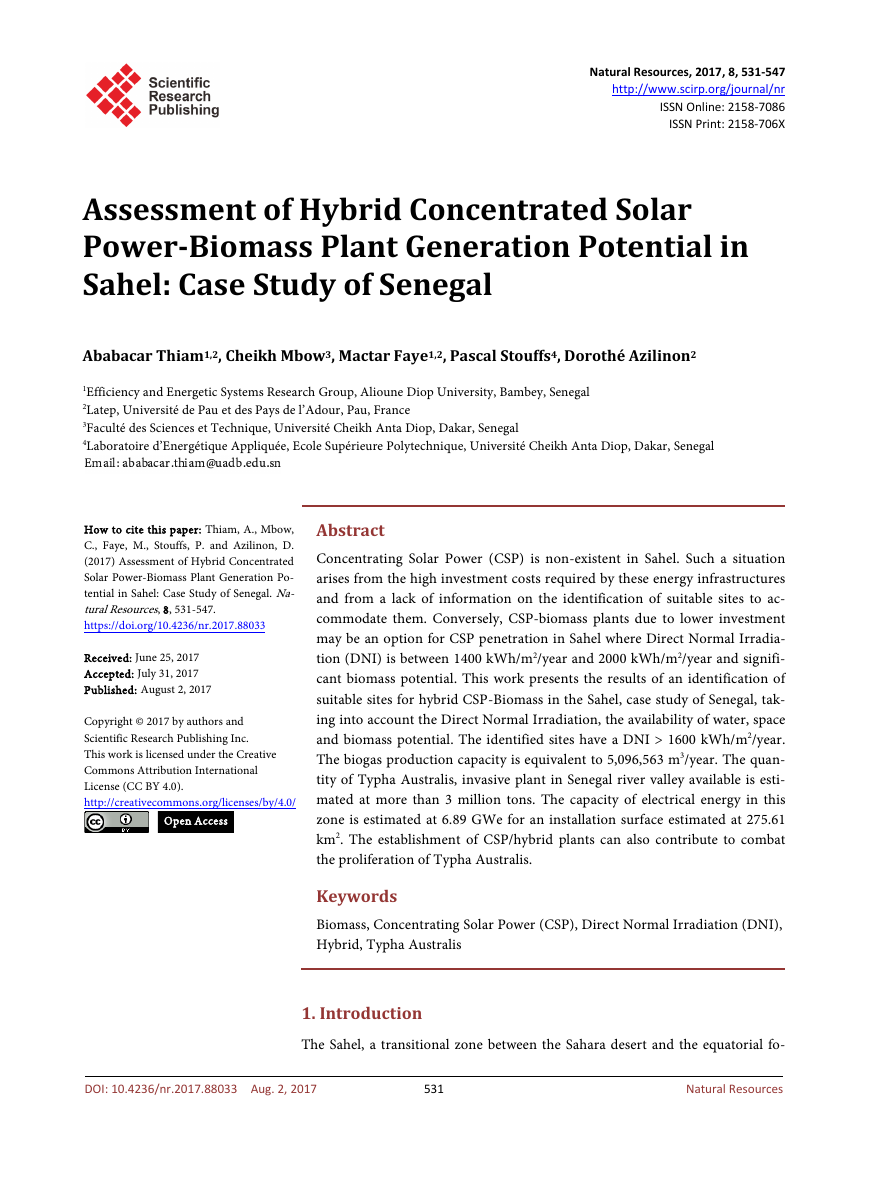
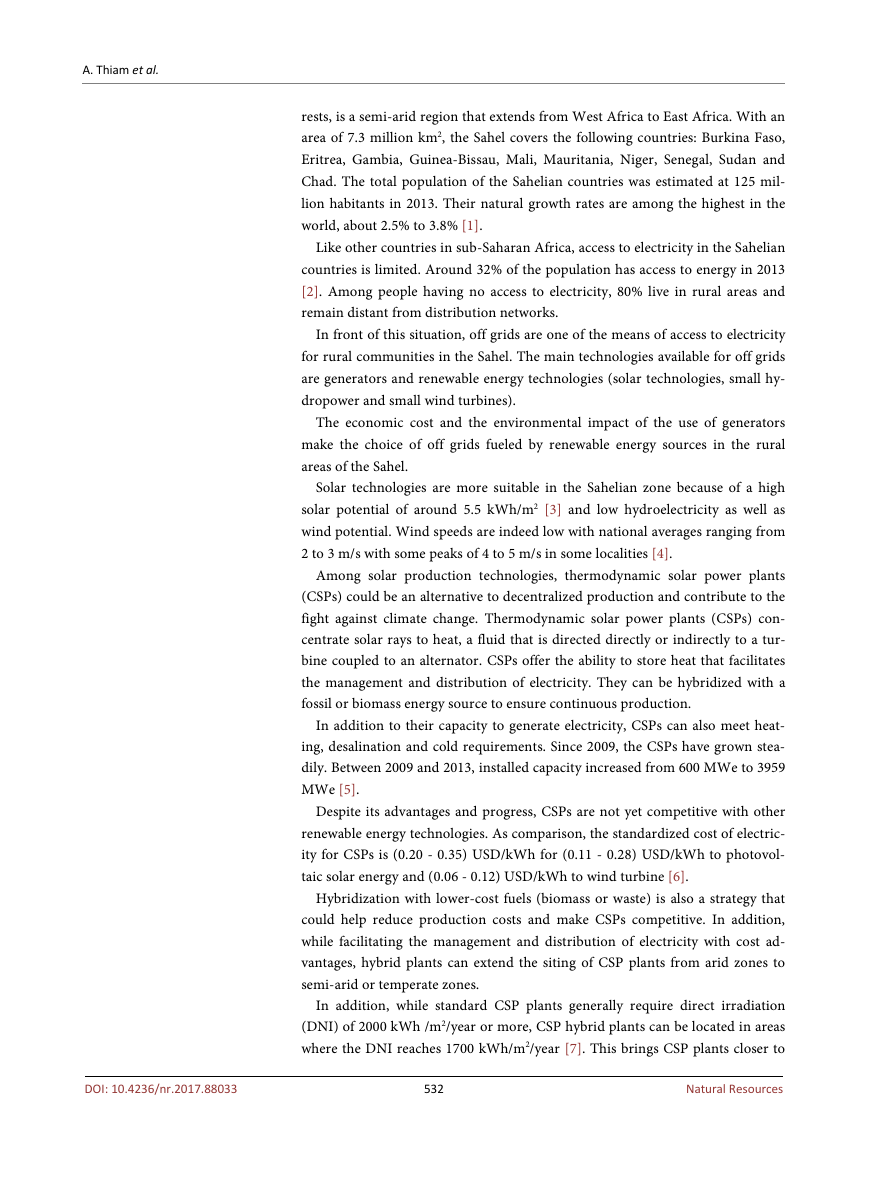
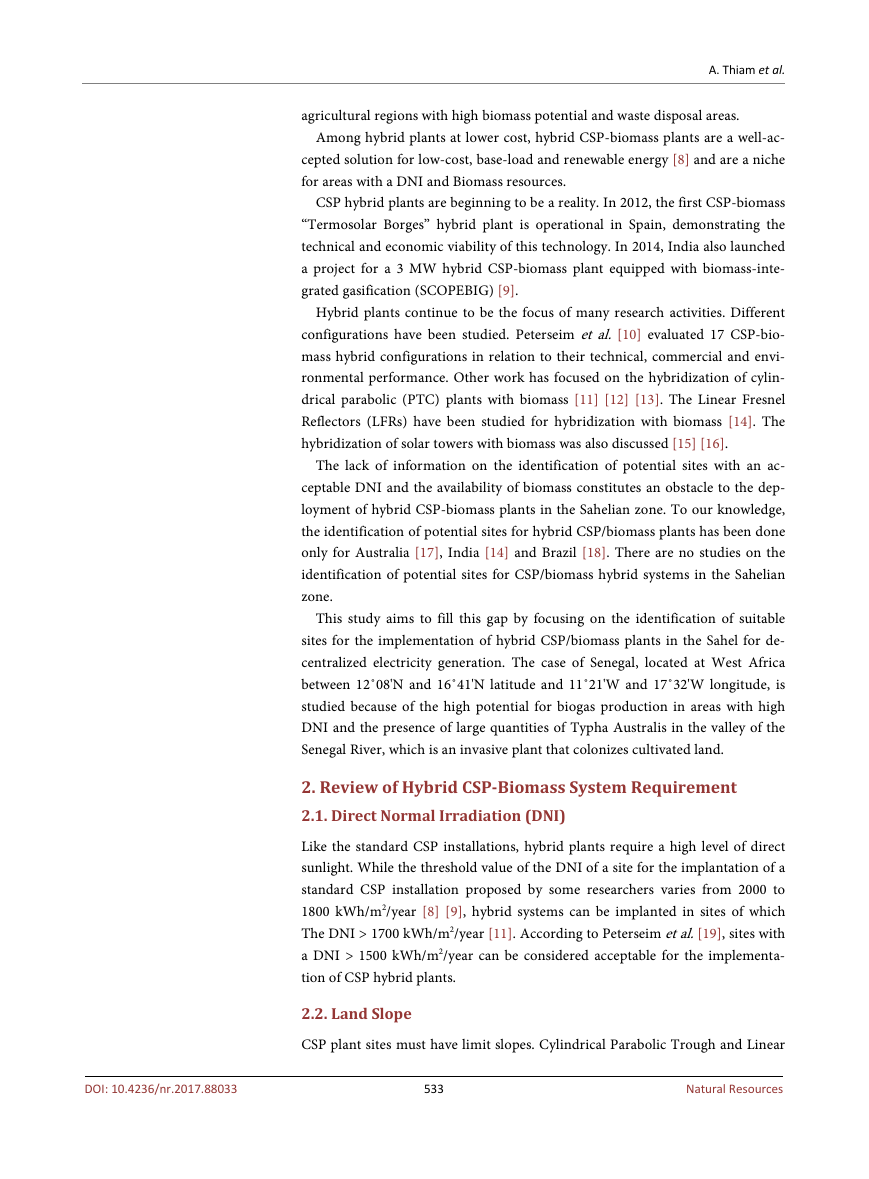
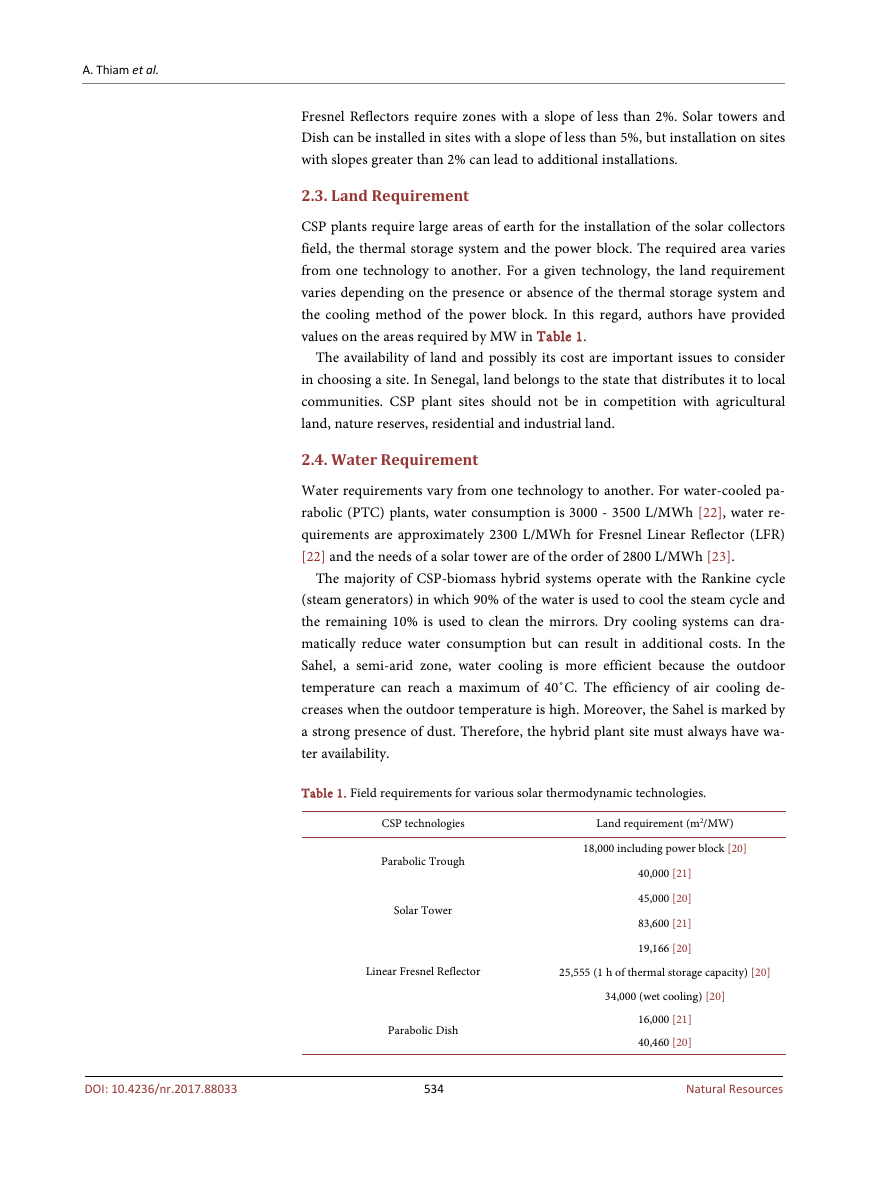

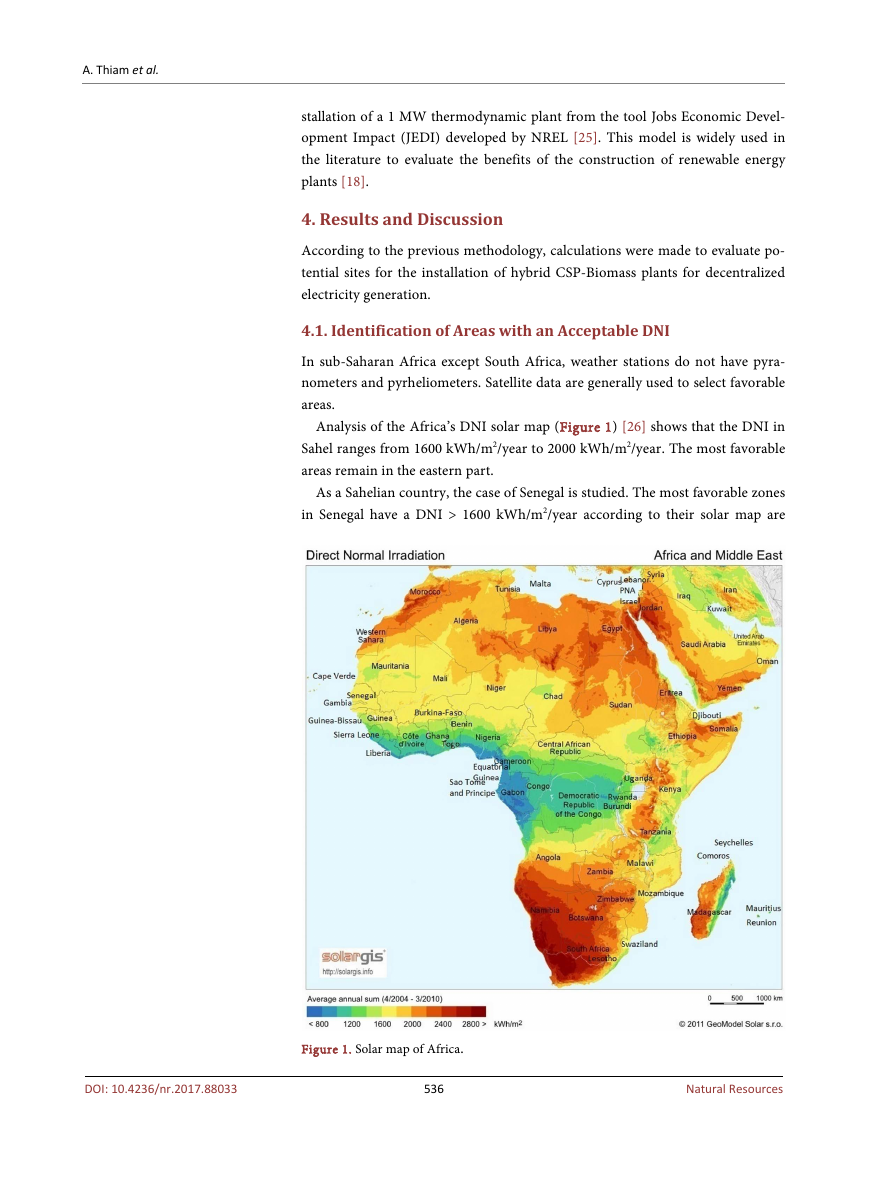
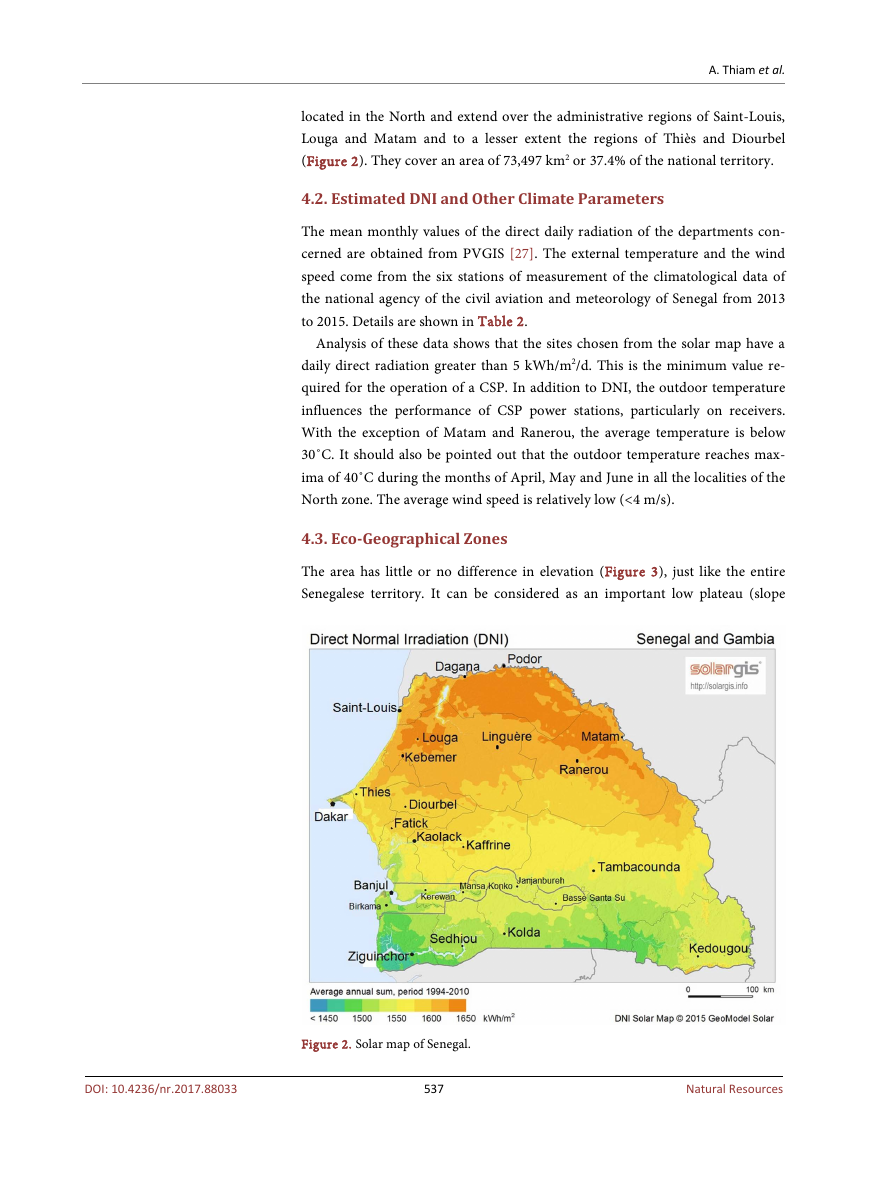
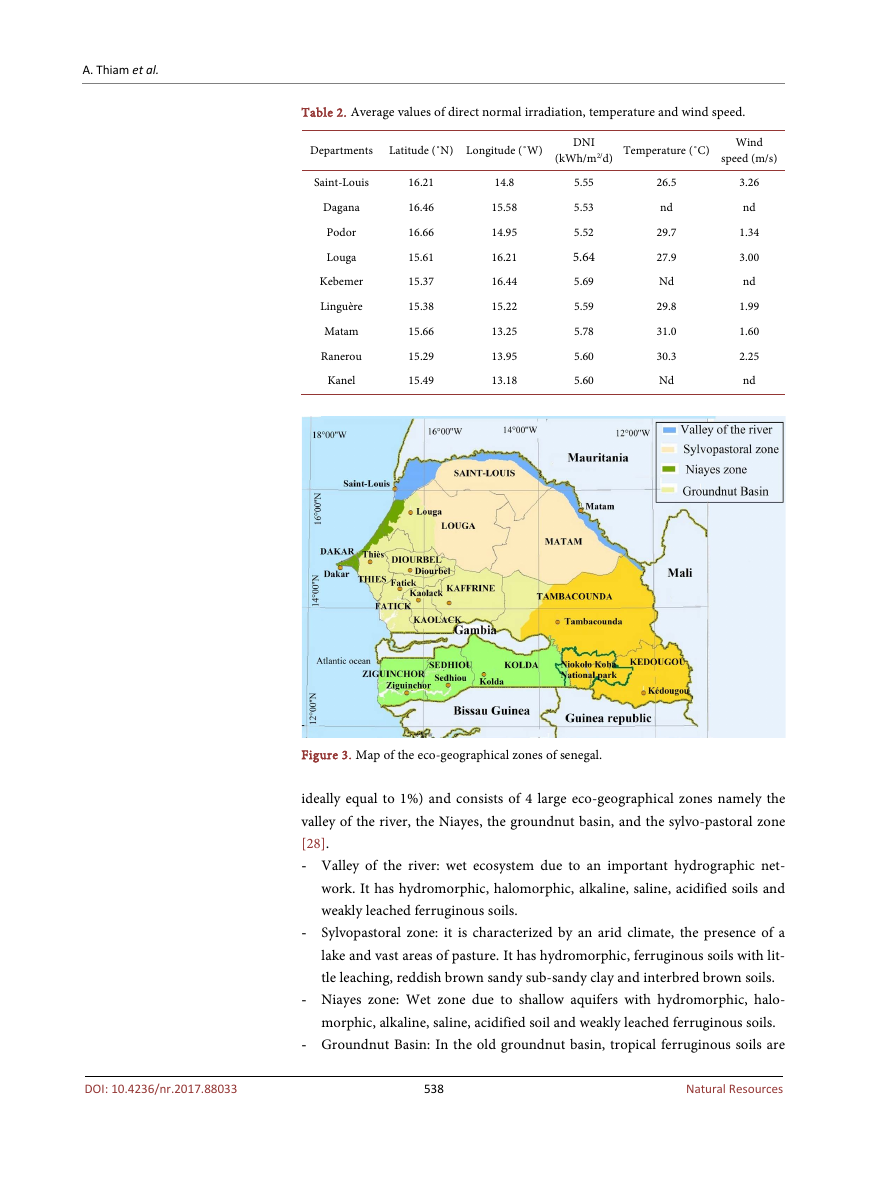








 2023年江西萍乡中考道德与法治真题及答案.doc
2023年江西萍乡中考道德与法治真题及答案.doc 2012年重庆南川中考生物真题及答案.doc
2012年重庆南川中考生物真题及答案.doc 2013年江西师范大学地理学综合及文艺理论基础考研真题.doc
2013年江西师范大学地理学综合及文艺理论基础考研真题.doc 2020年四川甘孜小升初语文真题及答案I卷.doc
2020年四川甘孜小升初语文真题及答案I卷.doc 2020年注册岩土工程师专业基础考试真题及答案.doc
2020年注册岩土工程师专业基础考试真题及答案.doc 2023-2024学年福建省厦门市九年级上学期数学月考试题及答案.doc
2023-2024学年福建省厦门市九年级上学期数学月考试题及答案.doc 2021-2022学年辽宁省沈阳市大东区九年级上学期语文期末试题及答案.doc
2021-2022学年辽宁省沈阳市大东区九年级上学期语文期末试题及答案.doc 2022-2023学年北京东城区初三第一学期物理期末试卷及答案.doc
2022-2023学年北京东城区初三第一学期物理期末试卷及答案.doc 2018上半年江西教师资格初中地理学科知识与教学能力真题及答案.doc
2018上半年江西教师资格初中地理学科知识与教学能力真题及答案.doc 2012年河北国家公务员申论考试真题及答案-省级.doc
2012年河北国家公务员申论考试真题及答案-省级.doc 2020-2021学年江苏省扬州市江都区邵樊片九年级上学期数学第一次质量检测试题及答案.doc
2020-2021学年江苏省扬州市江都区邵樊片九年级上学期数学第一次质量检测试题及答案.doc 2022下半年黑龙江教师资格证中学综合素质真题及答案.doc
2022下半年黑龙江教师资格证中学综合素质真题及答案.doc